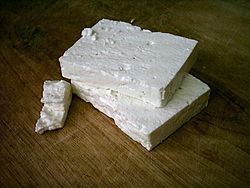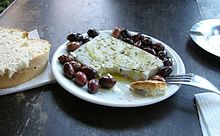Feta
The feta ( Greek (τυρί) φέτα [ (tiˈri) 'fɛta ], German ' feta cheese ' ) is a brine cheese . In its original meaning, it is a pressure-free milked sheep's cheese (sometimes also goat's cheese ), which has been matured in brine and has a very intense taste.
history
This type of cheese has been produced in Greece since ancient times and for personal consumption. A mention of feta cheese goes back to 1494, when an Italian traveler saw the cheese stored in barrels in the port of Candia ; he was referred to as Prosfatos , which means something like "recent" or "fresh". Over time , the cheese became established in Greece as feta , the word for "slice", which was taken over from the Italian fetta into Greek in the 17th century , as this cheese was sliced and produced on the Greek mainland and the islands of the former prefecture of Lesbos was stored in barrels with brine .
After this sheep's cheese enjoyed great popularity in many European countries, brine cheeses from other regions of the EU (which were often made from cheaper cow's milk ) were also sold as feta until 1997 .
Protection of the term by the EU Commission
According to Regulation (EC) No. 1829/2002 of the EU Commission , since October 15, 2002, only white cheese matured in brine from sheep and / or goat milk, which is produced on the Greek mainland and the islands of the former prefecture of Lesbos, is allowed has been named Feta . This Commission regulation , which was challenged by Germany and Denmark (with the support of France and the United Kingdom ), was upheld by the European Court of Justice (ECJ) in a judgment of 25 October 2005 (Az. C-465/02; C-466/02 ).
One of the reasons for this EU decision was that around 60% of the EU's feta cheese was being produced in Greece at the time, and 90% when it was made from sheep and goat milk. 34% of the feta produced in the EU was made from cow's milk, which was mainly intended for export to third countries. Over 85% of the feta produced in the EU was consumed in Greece. Before the EU decision, only Greece (from 1935) and Denmark (from 1963) had detailed legislation on the trade in feta cheese, and the Netherlands between 1981 and 1998. In Austria the term feta was based on a bilateral agreement of 1972 with the Kingdom Greece reserved for Greek products. Denmark has mainly produced this cheese for export since the 1930s. The production peak was here in 1989 with 110,932 tons (production here according to the old rule almost exclusively from cow's milk). The EU argued that there was no evidence of a generic name called feta . The protected geographical name Φέτα (Feta) led to the fact that the original Feta was only produced on the Greek mainland and the former prefecture of Lesbos. Only there the special milk of the traditionally kept sheep and goats of local races can be produced, because only there this special grazing area flora occurs, which in turn has influenced the breed formation of the animals. This also includes extensive grazing and migratory animal husbandry as key elements for keeping the sheep and goats, which provide the raw material for the production of feta cheese.
Responses to the protection of the term
Since the term feta can no longer be used for products from other regions than the original or for brine cheese made from any milk, packaging is provided with Greek-like names or illustrations. Substitute names are also invented that seem more image-enhancing than the correct term brine cheese . Such bypass constructs are: cheese (feta type) , Pheta , Balkan cheese , white cheese , cheese to Balkanart , White cheese , Hetaxkäse , Schipkakäse (under this name was the Bulgarian brine cheese in the GDR known), salad cheese Greek style and German shepherds cheese in the traditional Art . The terms sheep cheese , sheep cheese or Greek cheese are forbidden to mislead customers if the cheese is not made from sheep's milk or does not come from Greece .
Some manufacturers sell both products that are made from sheep's milk in the region of origin and products that do not meet these criteria. The brand alone becomes the outstanding characteristic of the products. Other manufacturers are creating new brand names that are clearly based on the term feta and are using them to market products made from cow's milk.
Web links
Individual evidence
- ↑ a b c REGULATION (EC) No. 1829/2002 OF THE COMMISSION of October 14, 2002. (pdf; 146 kB) Accessed on October 2, 2017 .
- ^ Judgment of the ECJ of October 25, 2005
- ↑ Federal Law Gazette No. 378/1972 , Agreement between the Republic of Austria and the Kingdom of Greece on the protection of indications of source, designations of origin and names of agricultural and commercial products
- ↑ Achim Spiller, Julian Voss: EU protection of indications of origin: Quo vadis consequences of the court ruling of the ECJ on the designation of origin "Feta" . 2006 ( PDF online discussion contribution). (accessed on: December 15, 2012).

